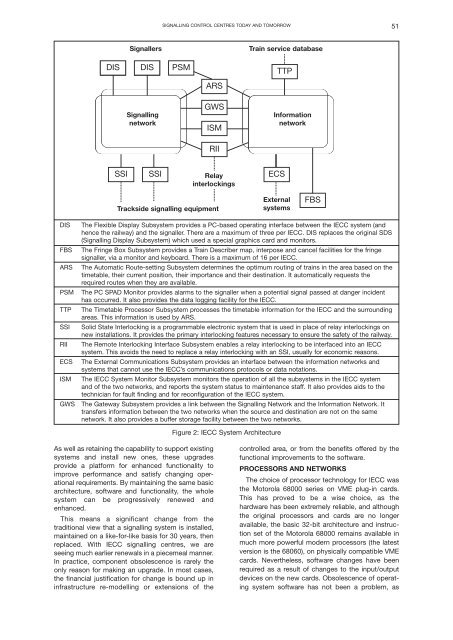Proceedings 2002/2003 - IRSE
Proceedings 2002/2003 - IRSE
Proceedings 2002/2003 - IRSE
You also want an ePaper? Increase the reach of your titles
YUMPU automatically turns print PDFs into web optimized ePapers that Google loves.
SIGNALLING CONTROL CENTRES TODAY AND TOMORROW 51<br />
Signallers<br />
Train service database<br />
DIS<br />
DIS<br />
PSM<br />
TTP<br />
ARS<br />
Signalling<br />
network<br />
GWS<br />
ISM<br />
Information<br />
network<br />
RII<br />
SSI<br />
SSI<br />
Relay<br />
interlockings<br />
ECS<br />
Trackside signalling equipment<br />
External<br />
systems<br />
FBS<br />
DIS<br />
FBS<br />
ARS<br />
PSM<br />
TTP<br />
SSI<br />
RII<br />
ECS<br />
ISM<br />
GWS<br />
The Flexible Display Subsystem provides a PC-based operating interface between the IECC system (and<br />
hence the railway) and the signaller. There are a maximum of three per IECC. DIS replaces the original SDS<br />
(Signalling Display Subsystem) which used a special graphics card and monitors.<br />
The Fringe Box Subsystem provides a Train Describer map, interpose and cancel facilities for the fringe<br />
signaller, via a monitor and keyboard. There is a maximum of 16 per IECC.<br />
The Automatic Route-setting Subsystem determines the optimum routing of trains in the area based on the<br />
timetable, their current position, their importance and their destination. It automatically requests the<br />
required routes when they are available.<br />
The PC SPAD Monitor provides alarms to the signaller when a potential signal passed at danger incident<br />
has occurred. It also provides the data logging facility for the IECC.<br />
The Timetable Processor Subsystem processes the timetable information for the IECC and the surrounding<br />
areas. This information is used by ARS.<br />
Solid State Interlocking is a programmable electronic system that is used in place of relay interlockings on<br />
new installations. It provides the primary interlocking features necessary to ensure the safety of the railway.<br />
The Remote Interlocking Interface Subsystem enables a relay interlocking to be interfaced into an IECC<br />
system. This avoids the need to replace a relay interlocking with an SSI, usually for economic reasons.<br />
The External Communications Subsystem provides an interface between the information networks and<br />
systems that cannot use the IECC’s communications protocols or data notations.<br />
The IECC System Monitor Subsystem monitors the operation of all the subsystems in the IECC system<br />
and of the two networks, and reports the system status to maintenance staff. It also provides aids to the<br />
technician for fault finding and for reconfiguration of the IECC system.<br />
The Gateway Subsystem provides a link between the Signalling Network and the Information Network. It<br />
transfers information between the two networks when the source and destination are not on the same<br />
network. It also provides a buffer storage facility between the two networks.<br />
Figure 2: IECC System Architecture<br />
As well as retaining the capability to support existing<br />
systems and install new ones, these upgrades<br />
provide a platform for enhanced functionality to<br />
improve performance and satisfy changing operational<br />
requirements. By maintaining the same basic<br />
architecture, software and functionality, the whole<br />
system can be progressively renewed and<br />
enhanced.<br />
This means a significant change from the<br />
traditional view that a signalling system is installed,<br />
maintained on a like-for-like basis for 30 years, then<br />
replaced. With IECC signalling centres, we are<br />
seeing much earlier renewals in a piecemeal manner.<br />
In practice, component obsolescence is rarely the<br />
only reason for making an upgrade. In most cases,<br />
the financial justification for change is bound up in<br />
infrastructure re-modelling or extensions of the<br />
controlled area, or from the benefits offered by the<br />
functional improvements to the software.<br />
PROCESSORS AND NETWORKS<br />
The choice of processor technology for IECC was<br />
the Motorola 68000 series on VME plug-in cards.<br />
This has proved to be a wise choice, as the<br />
hardware has been extremely reliable, and although<br />
the original processors and cards are no longer<br />
available, the basic 32-bit architecture and instruction<br />
set of the Motorola 68000 remains available in<br />
much more powerful modern processors (the latest<br />
version is the 68060), on physically compatible VME<br />
cards. Nevertheless, software changes have been<br />
required as a result of changes to the input/output<br />
devices on the new cards. Obsolescence of operating<br />
system software has not been a problem, as

















